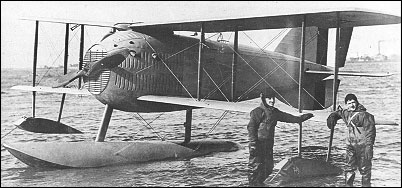|
| Designed by Capt B L Smith of the US Marine Corps as a
two-seat patrol fighter floatplane for use in the Dunkirk-
Calais area, the HA - known unofficially as the "Dunkirk
Fighter" - was intended to combat the Brandenburg
float fighters and was built at the experimental
plant of the Curtiss Engineering Corporation. Of conventional
wooden construction with fabric skinning,
the HA was powered by a 425hp Liberty 12 engine and
featured an unusually rotund fuselage. Proposed armament
comprised two synchronized 7.62mm
Marlin machine guns and two Lewis guns of the same
calibre on a Scarff mounting in the rear cockpit. The HA
was flown for the first time on 21 March 1918, but was
found to be unstable longitudinally and seriously tail
heavy. The initial test terminated in a crash. Curtiss
was then awarded a contract for two further prototypes,
the first of which, the HA-1, utilized salvaged components from the original HA and featured revised
vertical tail surfaces, an annular-type radiator and relocated
wings. The HA-1 demonstrated appreciably improved
handling qualities, but was written off after a
fire in the air. The third HA prototype, the HA-2, differed
appreciably from the HA-1.
| MODEL | HA-1 |
| WEIGHTS |
| Take-off weight | 1634 kg | 3602 lb |
| Empty weight | 1111 kg | 2449 lb |
| DIMENSIONS |
| Wingspan | 10.97 m | 36 ft 0 in |
| Length | 9.37 m | 31 ft 9 in |
| Height | 3.23 m | 11 ft 7 in |
| Wing area | 35.95 m2 | 386.96 sq ft |
| PERFORMANCE |
| Max. speed | 203 km/h | 126 mph |
| NAS Rockaway, e-mail, 31.12.2013 04:11 Photo was taken at NAS Rockaway. Barren Island Brooklyn is visible in the background. reply | | Colonel Joe Reich, e-mail, 24.06.2013 23:51 Did B.L. Smith fly any of them? Is he in the picture? reply |
|
Do you have any comments?
|
| 
COMPANY
PROFILE
All the World's Rotorcraft
|






